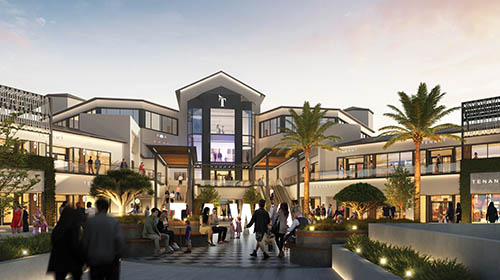— By Anthony Sanchez —
Riding the rising wave of retail demand through strategic repositioning.
Good news for retail and restaurant stakeholders: demand for in-person shopping, services, dining, entertainment and activities is on the rise.
Research shows that annual U.S. retail growth more than tripled year-over-year between 2010 and 2021, nearly 90% of retail sales are still occurring in person and more than half of U.S. consumers dined out more often in 2022 over the previous year. What’s more, among open-air lifestyle centers, March 2023 visits increased 15.3% month over month. And, in Q4 2022, shopping center vacancy reached its lowest level since 2007 with store openings in 2022 outpacing closures by nearly 2,500 — marking the largest net expansion in a decade.
With fundamentals brightening and consumers demonstrating a healthy appetite for visiting restaurants and shopping centers once more, owners and facility managers of retail centers are searching for ways to capitalize on these trends. One way that is rapidly gaining ground is strategic repositioning of older, outdated properties into exciting new retail and restaurant venues that capture consumers’ attention — and dollars.
As a leading architecture and design firm with more than 50 years of experience in optimizing commercial properties, we have witnessed many changes in retail real estate and spearheaded numerous successful shopping center redevelopments. Here’s why we believe strategic repositioning will remain robust and how it can help retail owners and operators benefit from the sector’s resurgence.
Elevating the Customer Experience and Driving NOI
While the convenience of online shopping/food delivery and the years-long pandemic kept many people from frequenting restaurants and retail stores, customers are now interested in returning to these places to have enjoyable and memorable experiences. Updated shopping centers can meet this demand by providing experiences that consumers can’t get from behind a screen, increasing foot traffic and sales in the process.
Refurbishing a retail center can elevate the customer experience in many ways. Retail centers and restaurants are being redesigned to deliver spaces for activities that captivate audiences — such as live music, cooking or craft demonstrations, classes, dancing or simply places for people to gather, socialize and take a break in between shopping, dining and browsing.

Incorporating central gathering spaces or even “outdoor living rooms” that bring visitors together and encourage them to lengthen their stay is a strategy we have used often in our repositioning efforts. An example of this is Universal Shopping Plaza, also known as Focus Plaza, a 220,000-square-foot shopping center in San Gabriel, California. We are currently revitalizing this property into TAWA Gateway, an environment that magnetizes people with outstanding shopping, dining and experiences. The renewed center will feature umbrella-shaded spaces with soft seating, beautiful landscaping and lighting to encourage night-time use.
Refreshing the architecture and improving the landscaping around and throughout the property, as we are also doing at TAWA Gateway, can increase a center’s aesthetic appeal and draw in visitors. These simple changes can have a tremendous impact on a property’s market relevancy and on its bottom line.
Bringing in New Tenants and Building Brand Awareness
Retailers are eager to be located at renewed centers that look fresh and interesting, attracting both locals and guests from many miles around. Revitalizing an obsolete or underperforming shopping and dining venue can help bring in tenants while helping new and existing retailers build brand awareness.
Owners and operators that focus their repositioning efforts on tenants’ needs can bolster business for everyone on their rent roll. This is especially relevant for local and/or smaller retailers, who may be struggling to gain market share, particularly at a time when economic uncertainty is prevalent. For example, Chophouse Row, a mixed-use urban development in Seattle, focuses on supporting small businesses and attracting innovative local tenants by offering compact commercial spaces that range from 285 to roughly 1,300 square feet. The development then leases these smaller space options at a higher price per square foot than its larger spaces — a strategy that generates income for the center while enabling it to improve its common areas and amenities.
Repositioning plans that incorporate tenants’ needs can benefit entrepreneurs while helping stakeholders increase their centers’ stability and performance.
Enhancing the Surrounding Community
Shopping centers that add value to the neighborhoods in which they are located present a win-win situation. They are not only likely to be successful, but also welcomed by area residents and municipalities. Locals with a YIMBY attitude about a nearby retail development are more inclined to frequent that venue and recommend it to their friends, families and neighbors.
Repositioning an older, perhaps obsolete, retail center can infuse the surrounding community with new life and potential. Replacing worn-out structures with a host of innovative and exciting shopping, dining and entertainment concepts can have an increasingly positive impact on everyone involved.
For one, rejuvenated centers instantly connote that an area is desirable, safe and worthy of visiting. That in itself attracts investors, businesses and residents, which furthers the health of the community in countless ways, from job creation to tax revenue and beyond. The result is a sustainable region that begets future growth, opportunity and investment — a plus for all.
Conclusion
As the outlook for the retail and restaurant sector continues to improve, stakeholders are seeking new ways to increase their share of the pie. Repositioning outmoded shopping centers is an excellent strategy for accomplishing this goal in the current market. By elevating the customer experience and driving NOI, bringing in new tenants and building brand awareness, and enhancing the greater community, a thoughtful approach to repositioning can help owners and facility managers optimize their properties and revitalize regions for the long term.
— Anthony Sanchez is design director and principal, Nadel Architecture + Planning, a leading architecture and design firm with more than 50 years of experience in optimizing commercial properties.

